Autodesk Fusion 2D Contour Machining
Autodesk Fusion 360 Process for Contour Machining
This page is a step-by-step walkthrough for setting up a contour milling operation in Autodesk Fusion for the WorkBee CNC specifically, but it should be easy to adapt this to any similar machine.
You will start with a New Fusion 360 Document and end up with a G-Code file ready to upload to the machine.
For further information and the explanation for each step, consult the Fusion 360 Documentation
Prepare
To get started, you will need to create the 2D geometry you’d like to mill out. For testing, a simple square with about 50 mm side length is a good starting point. Extrude it by the material thickness you plan to machine.
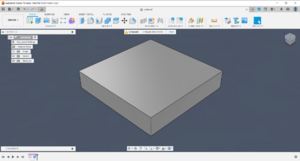
Then, in the top left corner of Fusion 360, switch from the “Design” workspace to the “Manufacture” workspace. This is where you’ll define your toolpaths and machine settings.
Import Workbee CNC
Before you get started, make sure you have properly imported the latest version of the machine definition and postprocessor into Fusion 360.
Check the last updated date on the GitHub page above. If you haven't imported the latest definitions since then, you'll need to add them.
At the top of the Fusion 360 Interface, select "Manage > Machine Library". Then under "My Machines > Local" you can import (NOT CREATE) the machine definition.
Also seperately import the post processor! Under the machine entry in your machine library in the "Post:" section, you can click the folder icon to import the latest post processor from the GitHub page.
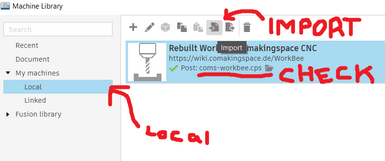
Create your Milling Tool
At the top of the Fusion 360 Interface, select "Manage > Tool Library" to open the tool library. Navigate to "Local > Library". This is where you'll save all of your endmill data.
Click on "[+]" to add a new tool. Select the appropriate geometry, most likely "Flat End Mill".
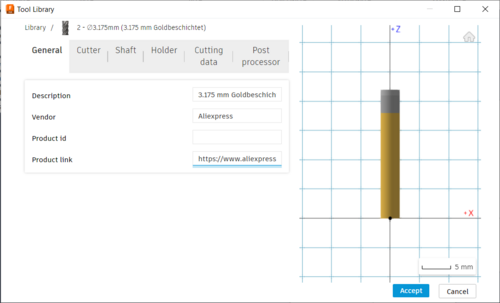
Tab 1: General
Here you can name your endmill. Describe them well, you'll mix them up otherwise. Also enter sourcing information (such as aliexpress links) here, you'll thank yourself later.
Tab 2: Cutter
Take Measurements of your tool for dimensions using calipers (Messschieber) and populate the values accordingly.
Adjust number of flutes and the geometry to match your endmill. I recommend setting "length below holder", "shoulder length" and "flute length" to the same value, that being the length of fully formed cutting flutes of your endmill.
Tab 3: Shaft
leave as is
Tab 4: Holder
leave as is
Tab 5: Cutting Data
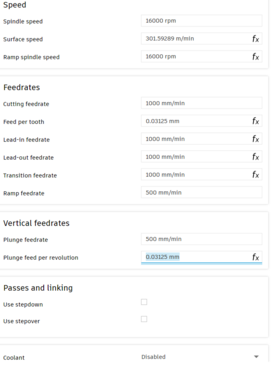
The following cutting data is a recommended starting point for a 1/8” (3.175mm) 2-flute flat nose endmill cutting plywood.
Many of the values (marked with fx) are calculated automatically and don't need adjusting.
Tweak these values as you gain experience:
- Spindle Speed (Drehzahl): 16,000 RPM
- Cutting Feedrate (Schnittvorschub): 1000 mm/min
- Ramp Feedrate (Helixvorschub): 500 mm/min
- Plunge Feedrate (Eintauchvorschub): 500 mm/min
- Coolant: DISABLE (To prevent errors, the WorkBee doesn’t have a coolant system)
Tab 6: Post Processor
leave as is.
Sanity check all data once over and click "accept" to confirm.
Configure Setup
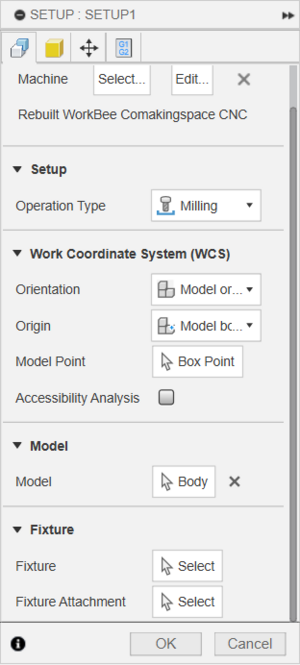
Create by selecting "Setup > New Setup"
Tab 1: Setup
- Machine:
- Select the latest machine definition
- Workpiece Coordinate System (WCS)
- Orientation: Model Orientation
- Origin: Model Box Point
- Model Point: Select Front-Left-Top corner
Tab 2: Stock
- Mode: Relative size box
- Stock side offset: 10 mm
- Stock top offset: 0 mm
- Stock bottom offset: 0 mm
Tab 3: Part Position
leave as is
Tab 4: Post Process
Optional: adjust program name.
leave as is.
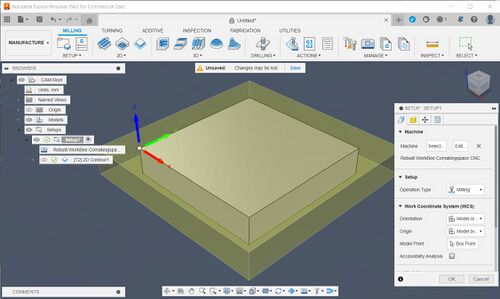
Set up 2D contour operation
At the top of the Fusion 360 Interface, select "2D > 2D Contour" to create a new 2D contour milling operation.
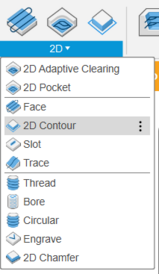
Tab 1: Tool
- Tool: Select the appropriate Tool
- Feed & Speed: Ensure the cut parameters are sane and have been properly inherited from the tool
Tab 2: Geometry
- Contour Selection: Select the 2D contour you want to machine (the bottom edge of your design)
- Tabs: Enable
- Tab Shape: Triangle
- Tab dimensions:
- Width: 6 mm
- Height: 3 mm
- Distance: 40 mm
Tab 3: Heights - leave as is
Tab 4: Passes
- Passes
- Sideways Compensation: Right (Rechtsfräsen)
- OPTIONAL: Preserve order Check this box if you have nested features (cutouts within cutouts) to maintain the cutting order
- Disable all the other options
Tab 5: Multi-Axis
- leave as is
Tab 6: Linking
- Lead-In: Deactivate
- Lead-Out: Deactivate
- Ramp: Enable
- Maximum Ramp Stepdown: Start with 3-6 mm and adjust based on endmill strength, desired cut quality, and material thickness
Confirm the Operation with OK. Fusion 360 will now display a preview of the operation.
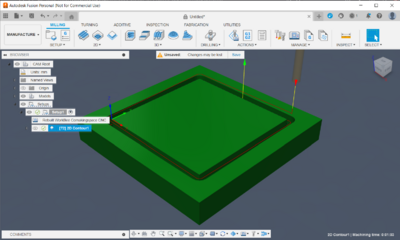
Simulate to check & Export
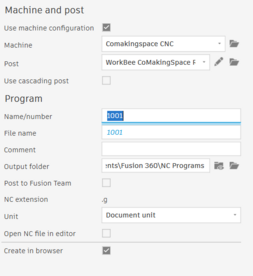
- At the top of the Fusion 360 Interface, use the “Actions > Simulate” tool to check you haven’t missed anything
- At the top of the Fusion 360 Interface, use "Actions > Post Process"
- Use Machine Configuration (“Maschinenkonfiguration verwenden”):
- Select Machine: “Comakingspace CNC”
- Double-check Post-Processor: “WorkBee CoMakingSpace RRF”
- Export
Your G-Code file is ready for upload to the CNC!